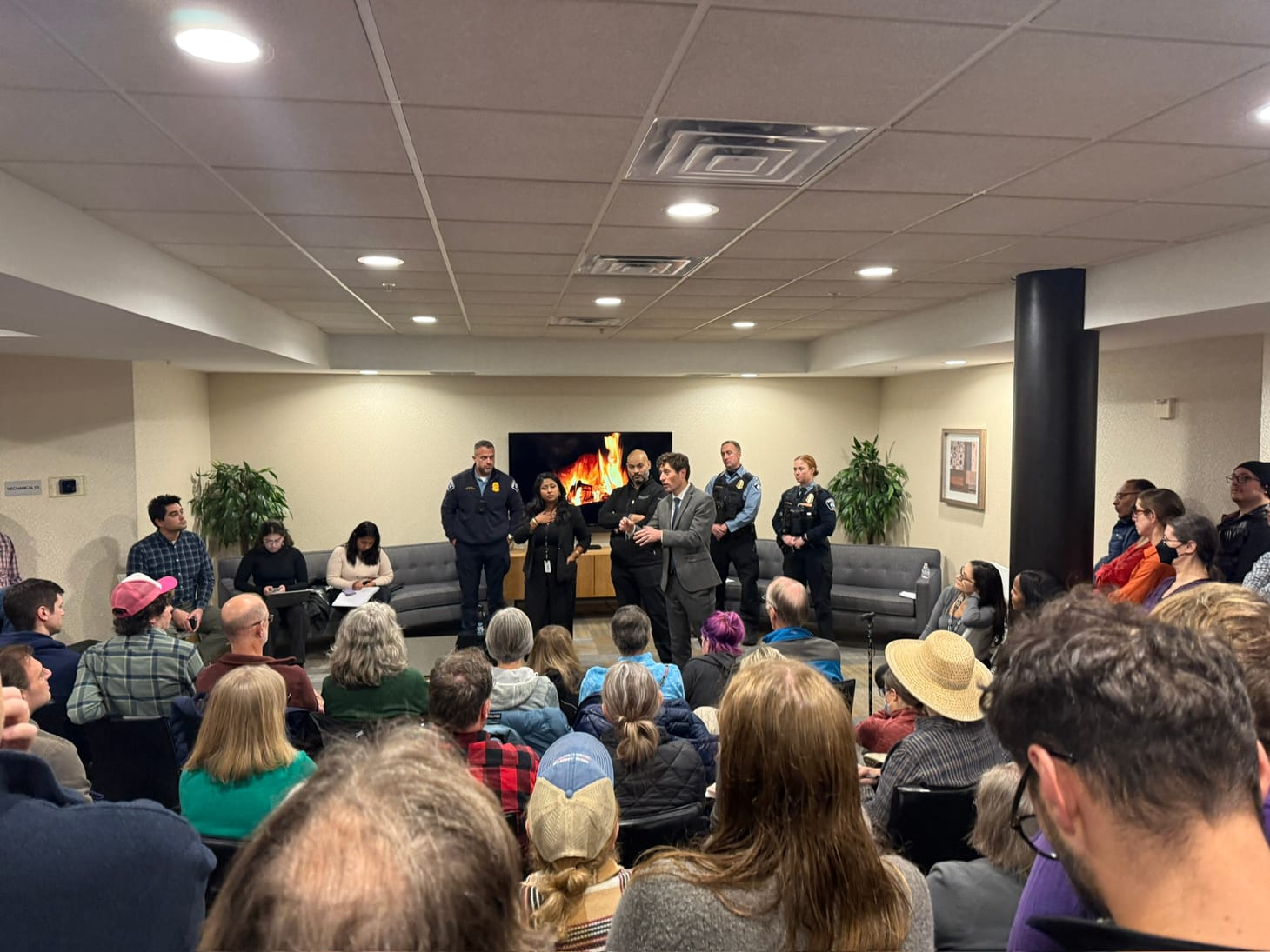👥 Tense neighborhood meeting reflects mounting concerns over safety around 46th and Hiawatha
More than 100 residents packed into a standing-room-only meeting at Hiawatha Flats Apartments on Wednesday night to discuss safety issues around the 46th and Hiawatha intersection with the mayor, police chief, and two city council members.

Note: This story is free for everyone. To access everything else, become a subscriber.
More than 100 residents packed into a standing-room-only meeting at Hiawatha Flats Apartments on Wednesday night to discuss safety issues around the 46th and Hiawatha intersection with the mayor, police chief, and two city council members, the latest expression of rising tensions among residents of that area that mirrors a larger citywide political debate around the complicated issues of crime, homelessness, drug use, and policing.
The meeting was originally scheduled as a small conversation between residents of the apartment complex on 43rd and Snelling and Councilmember Aurin Chowdhury, Police Chief Brian O’Hara, and Mayor Jacob Frey. But the flyer circulated quickly online and drew a much larger crowd than anticipated, along with Council President Elliot Payne and two additional police representatives.
The meeting was scheduled in the wake of a triple killing at a homeless encampment on city property across from the apartment complex last month, the latest incident in a visible rise in crime, homelessness, and drug use that has radiated out from the intersection in the past few years.
Councilmember Chowdhury, who represents the area and lives nearby, said that besides traffic calming, concerns about crime and livability near the intersection are the most common complaints her office receives. Burger King now only allows people in the building by request; the apartment building that houses Venn Brewing has removed much of its seating and installed spiky features to discourage sitting; Amber Apartments next to Walgreens is reportedly paying tens of thousands of dollars per month on round-the-clock security. Walgreens has announced plans to close 1,500 stores across the country in the next three years, and while it hasn’t announced which, many predict the troubled Hiawatha store will be among them. Several speakers at the meeting shared experiences with property crime and feeling unsafe walking in the area. Others described the indignities and inhumane conditions that people living in the encampments face and the need for more services to solve the issue.
Much of the discussion veered toward a broader debate about the appropriate response to homeless encampments, many of which cluster along the Hiawatha Avenue corridor and appear to be at least partly correlated with spikes in crime. The question of whether, how, and when to clear these encampments has often pitted the mayor against more progressive members of the city council and is shaping up to be one of the key issues in next year’s mayoral race.
At the meeting, Frey reiterated remarks he made in a press conference after the Snelling Avenue shooting, saying, "I need to be very honest about homeless encampments and, in part, why they exist. It is not about lack of shelter, for the most part...the primary driver is addiction," and defending the policy of routinely clearing encampments due to the safety risks they pose to people living in them and around them. Chowdhury and Payne countered that addiction is just one symptom of the broader problem of housing insecurity and that continually uprooting the encampments hinders recovery and worsens the issue. Chowdhury has led the council's efforts to increase reporting around the costs and tactics of these removals and consider legalizing designated "safe outdoor spaces." For his part, Chief O'Hara stressed that his force is down to a "critically low" level of 520 full-time patrol officers, and that his top priority is recruitment.
Around 46th and Hiawatha specifically, officials highlighted a few near-term efforts to address the issues:
- Chowdhury said she’s planning to propose an amendment to the city’s 2025 budget that would dedicate specific funding for safety programming around the intersection to “disrupt the antisocial behavior we’re seeing.” This would likely involve hiring existing safety and violence interruption groups already under contract in other areas of the city, such as T.O.U.C.H. Outreach, which works along East Lake Street and Nicollet Mall.
- A “46th and Hiawatha Coalition” formed last month as an attempt to improve communication between the city, Metro Transit, and the various landholders, business owners, and institutions in the area. After Minnesota Commercial Railway railroad cleared an encampment on its property behind Walgreens in September, Chowdhury lamented the challenge of coordinating between the various organizations ahead of the eviction to understand when the clearing was happening and connect people living there to services. The group plans to meet every other month.
- A group of officials — including Chowdhury, MPD Crime Prevention Specialist Shun Tillman, Third Precinct Inspector Jose Gomez, and city staff — have been meeting individually with apartment buildings in the area to discuss crime prevention strategies. One such meeting was with the CEO of RS EDEN, which operates the Amber Apartments, a transitional living facility for people coming out of homelessness that has received an outsized number of 911 and 311 complaints.
- Chowdhury is hosting a community safety meeting for her ward on November 26 at 5:30, though the venue has not been set. It will be an open-house style event with city officials on hand.
For a more detailed summary, Wedge Live provided a concise rundown of the comments.